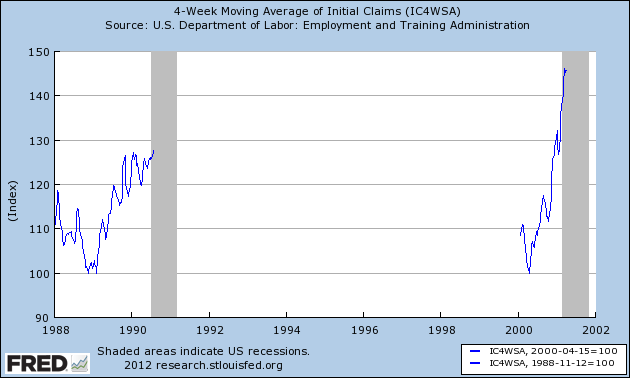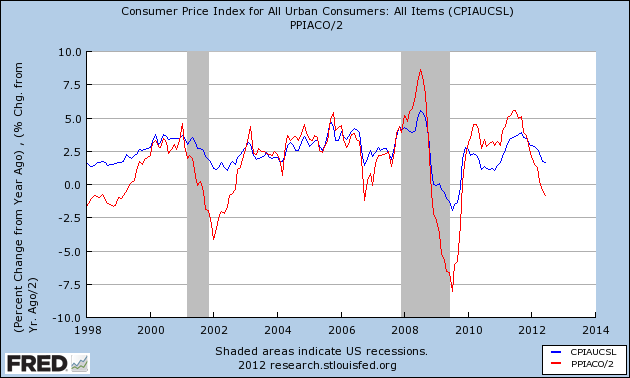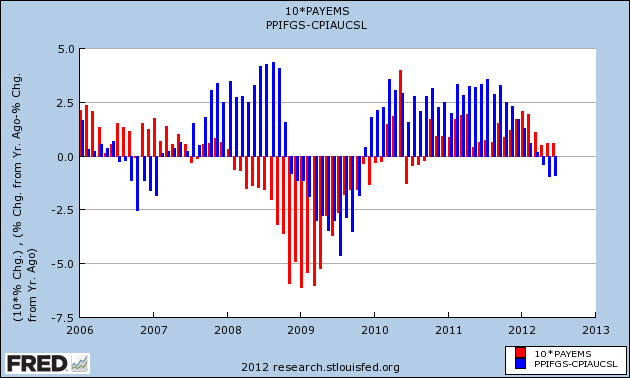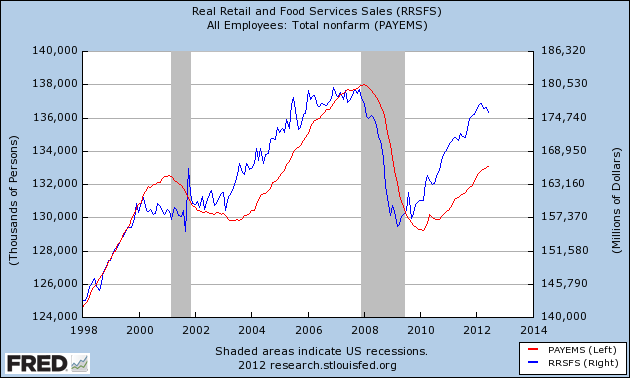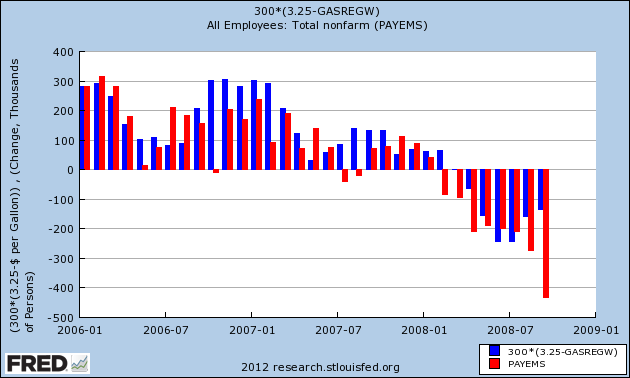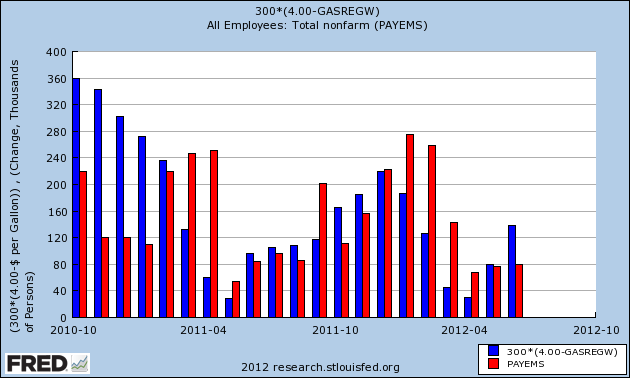- by New Deal democrat
Monthly data reported included very poor June real retail sales, off -0.5%. Consumer prices were flat, meaning -0.3% deflation for the 2nd quarter. Housing permits declined, although still at the third highest level in 4+ years. This contributed to a -0.3 decline in the June LEI, the second decline in 3 months. Existing home sales also dropped to a 6 month low. Housing starts, which usually follow permits by about a month, did rise to a 4+ year high, and industrial production also rose 0.4.
A reminder about my weekly look at the high frequency weekly indicators: they are not meant to be predictive at all. Rather, while reporting on monthly or quarterly data is "looking in the rear view mirror," by using data that is reported every week we are glancing out the side windows at what is happening virtually in real time. Although weekly data can be noisy, turns will show up here before they show up in monthly or quarterly data.
And indeed, a significant turn did show in consumer spending. Last year the smoothed Gallup daily consumer spending data showed that, despite concerns of an imminent recession from some last September, consumer spending was holding up. Meanwhile same store sales were almost uniformly running at over +2% YoY. Last winter, I identified this as a metric to watch. Beginning in May, this level was being frequently breached to the downside by at least one of the reporting services. By late June, Gallup spending in particular was basically flat YoY. All of this presaged the poor June retail sales number.
This week, Same Store Sales were decidedly mixed and Gallup was negative.
The ICSC reported that same store sales for the week ending July 14 were flat w/w, and were up +2.6% YoY. Johnson Redbook reported a 1.7% YoY gain. Shoppertrak, which has been very erratic, reported a +3.6% YoY gain. The 14 day average of Gallup daily consumer spending, at $67 was $4 under last year's $71 for this period. This is the fifth week in a row in which consumer spending has weakened significantly, and the worst YoY comparison in two months for the Gallup report. One year ago, sales were building to a good "back to school season" that peaked in early August. Since the beginning of June, however, sales have been in decline. This is now a red flag showing that consumers have turned cautious and that caution has continued into July.
Employment related indicators were also mixed to poor:
The Department of Labor reported that Initial jobless claims rose 36,000 from the prior week's unrevised 350,000, reversing all of its decline and then some from last week. The four week average fell 1000 to 375,500.
The Daily Treasury Statement for the first 13 reporting days of July was $97.5 B vs. $96.9 B a year ago, a very slight +0.6% improvement. For the last 20 days ending July 19, $135.0B was collected vs. $135.8B for the same period in 2011, an outright decline. This decline may be an artifact of the July 4 holiday, since an extra Monday is included in last year's number. Moving the average by one day either way results in a +$4B or +$7B gain.
The American Staffing Association Index fell by 5 to 88. This index has been generally flat for the last three months, mirroring its 2nd quarter flatness last year. The big decline this week is due to the July 4 artifact that happens every year. It should rebound next week.
The energy choke collar is close to re-engaging:
Gasoline prices rose again last week, up .02 to $3.43. Oil prices per barrel rose sharply during the week, and settled Friday up another $5, closing Friday at $91.83. Gasoline usage, at 8628 M gallons vs. 9028 M a year ago, was off -4.4%. The 4 week average at 8848 M vs. 9154 M one year ago is off -3.3%, still a significant YoY decline; however, June and early July of 2011 were the only months after March 2011 where there was a YoY increase in usage, so the YoY comparison now is especially difficult.
Bond prices and credit spreads both decreased:
Weekly BAA commercial bond rates fell .13% to 4.90%. These are the lowest yields in over 45 years. Yields on 10 year treasury bonds fell .09% to 1.52%. The credit spread between the two declined to 3.38%, but is still near its 52 week maximum. The recent collapse in bond yields shows fear of deflation due to economic weakness, as does the recent increase in credit spreads.
Housing reports remained mixed:
The Mortgage Bankers' Association reported that the seasonally adjusted Purchase Index declined a slight -0.1% from the week prior, but remained down approximately 3% YoY, back into the middle part of its two year range. The Refinance Index rose 22%, again at its 3 year high.
The Federal Reserve Bank's weekly H8 report of real estate loans this week rose +0.1%, and the YoY comparison remained at +0.9%. On a seasonally adjusted basis, these bottomed in September and is up +1.2%.
YoY weekly median asking house prices from 54 metropolitan areas at Housing Tracker were up + 2.7% from a year ago. YoY asking prices have been positive for 7 1/2 months, and remain higher than at any point last year.
Money supply was positive and is now being compared with the inflow tsunami of one year ago:
M1 rose +2.7% last week, and was up +1.8% month over month. Its YoY growth rate rose to +16.0%, so Real M1 is up 14.4% YoY. M2 was flat for the week, and was up 0.8% month/month. Its YoY growth rate remained at 8.5%, so Real M2 grew at +6.%. Real money supply indicators after slowing earlier this year, have increased again, but YoY comparisons are starting to wane as expected.
Rail traffic turned solidly positive:
The American Association of Railroads reported a +3.9% increase in total traffic YoY, or +20,300 cars. Non-intermodal rail carloads were up +1.7% YoY or +4600, as coal hauling turned solidly positive for the first time in months, up 3000 carloads YoY. Intermodal traffic was up 15,600 or 6.8% YoY. Negative comparisons, however, continued for 10 of the 20 carload types.
Turning now to high frequency indicators for the global economy:
The TED spread stayed at 0.37. In the last few weeks it has established new 52 week lows. The one month LIBOR declined slightly 0.2468. It has risen significantly above its recent 4 month range, it remains well below its 2010 peak, and has still within its typical background reading of the last 3 years. Even with the recent scandal surrounding LIBOR, it is probably still useful in terms of whether it is rising or falling.
The Baltic Dry Index fell another 73 to 1037. It is still 367 points above its February 52 week low of 670, although well below its October 2011 peak near 2200. The Harpex Shipping Index fell for the seventh from 430 to 423, but is still up 47 from its February low of 375.
Finally, the JoC ECRI industrial commodities index rose from 116.13 to 118.73. This is still near its 52 week low. Its recent 10%+ downturn during the last few months remains a strong sign of all that the globe taken as a whole is slipping back into recession, and its increase in the last two weeks is probably primarily due to the price of Oil.
While as I have said for the last several weeks, weakness has grown widespread, the most positive signs are in the long leading indicators of bond yields, money supply, and housing. Labor indicators remain weak, and it is particularly ominous that the Oil choke collar is close to re-engaging just when consumers appear to be rolling over.
Have a nice weekend!





